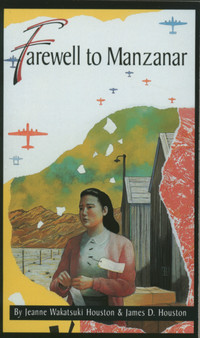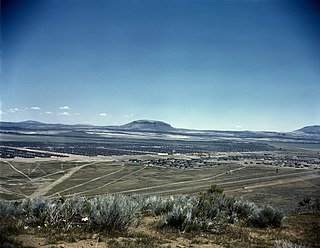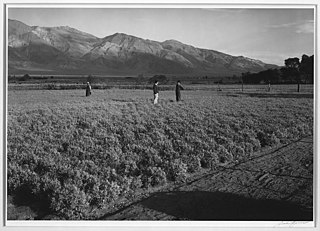Related Research Articles

Manzanar is the site of one of ten American concentration camps, where more than 120,000 Japanese Americans were incarcerated during World War II from March 1942 to November 1945. Although it had over 10,000 inmates at its peak, it was one of the smaller internment camps. It is located at the foot of the Sierra Nevada mountains in California's Owens Valley, between the towns of Lone Pine to the south and Independence to the north, approximately 230 miles (370 km) north of Los Angeles. Manzanar means "apple orchard" in Spanish. The Manzanar National Historic Site, which preserves and interprets the legacy of Japanese American incarceration in the United States, was identified by the United States National Park Service as the best-preserved of the ten former camp sites.

During World War II, the United States forcibly relocated and incarcerated about 120,000 people of Japanese descent in ten concentration camps operated by the War Relocation Authority (WRA), mostly in the western interior of the country. Approximately two-thirds of the detainees were United States citizens. These actions were initiated by Executive Order 9066, issued by President Franklin D. Roosevelt on February 19, 1942, following Imperial Japan's attack on Pearl Harbor in December 1941. Before the war, about 127,000 Japanese Americans lived in the continental United States, of which about 112,000 lived on the West Coast. About 80,000 were Nisei and Sansei. The rest were Issei immigrants born in Japan, who were ineligible for citizenship. In Hawaii, where more than 150,000 Japanese Americans comprised more than one-third of the territory's population, only 1,200 to 1,800 were incarcerated.

Farewell to Manzanar is a memoir published in 1973 by Jeanne Wakatsuki Houston and James D. Houston. The book describes the experiences of Jeanne Wakatsuki and her family before, during, and following their relocation to the Manzanar internment camp due to the United States government's internment of Japanese Americans during World War II. It was adapted into a made-for-TV movie in 1976 starring Yuki Shimoda, Nobu McCarthy, James Saito, Pat Morita, and Mako.

The Tule Lake National Monument in Modoc and Siskiyou counties in California, consists primarily of the site of the Tule Lake War Relocation Center, one of ten concentration camps constructed in 1942 by the United States government to incarcerate Japanese Americans forcibly removed from their homes on the West Coast. They totaled nearly 120,000 people, more than two-thirds of whom were United States citizens. Among the inmates, the notation "鶴嶺湖" was sometimes applied.

Minidoka National Historic Site is a National Historic Site in the western United States. It commemorates the more than 13,000 Japanese Americans who were imprisoned at the Minidoka War Relocation Center during the Second World War. Among the inmates, the notation 峰土香 or 峯土香 was sometimes applied.
Togo W. Tanaka was an American newspaper journalist and editor who reported on the difficult conditions in the Manzanar camp, where he was one of 110,000 Japanese Americans who had been relocated after the Japanese attack on Pearl Harbor on December 7, 1941.

The Manzanar Children's Village was an orphanage for children of Japanese ancestry incarcerated during World War II as a result of Executive Order 9066, under which President Franklin D. Roosevelt authorized the forced removal of Japanese Americans from the West Coast of the United States. Contained within the Manzanar concentration camp in Owens Valley, California, it held a total of 101 orphans from June 1942 to September 1945.
Aiko Herzig-Yoshinaga was a Japanese American political activist who played a major role in the Japanese American redress movement. She was the lead researcher of the Commission on Wartime Relocation and Internment of Civilians (CWRIC), a bipartisan federal committee appointed by Congress in 1980 to review the causes and effects of the Japanese American incarceration during World War II. As a young woman, Herzig-Yoshinaga was confined in the Manzanar Concentration Camp in California, the Jerome War Relocation Center in Arkansas, and the Rohwer War Relocation Center, which is also in Arkansas. She later uncovered government documents that debunked the wartime administration's claims of "military necessity" and helped compile the CWRIC's final report, Personal Justice Denied, which led to the issuance of a formal apology and reparations for former camp inmates. She also contributed pivotal evidence and testimony to the Hirabayashi, Korematsu and Yasui coram nobis cases.

Sue Kunitomi Embrey was an American teacher, activist and long-time chair of the Manzanar Committee, which established the annual Manzanar pilgrimage and obtained National Historic Site status for the former concentration camp.
Brittany Mariko Ishibashi is an American actress. She has had starring television roles on Political Animals, Supernatural and Runaways. Ishibashi has had roles in films such as Teenage Mutant Ninja Turtles: Out of the Shadows.

Joyce Nakamura Okazaki is an American citizen of Japanese heritage who was forcibly removed with her family from their Los Angeles home and placed in the Manzanar War Relocation camp in 1942. She was photographed by Ansel Adams in both 1943 and 1944 for his book, Born Free and Equal: The Story of Loyal Japanese Americans. In the 2001 reprint of the book, Okazaki's photograph appeared on the book jacket cover. She was the treasurer of the Manzanar Committee, from July 2010 to February 2021, an NGO which promotes education about the World War II incarceration of Japanese-Americans.
The Japanese American Evacuation and Resettlement Study (JERS) was a research project funded by the War Relocation Authority (WRA), an agency responsible for overseeing the relocation of Japanese Americans, The University of California, the Giannini Foundation, the Columbian Foundation, and the Rockefeller Foundation with the total amount of funding reaching almost 100,000 U.S. dollars. It was conducted by a team of social scientists at the University of California, Berkeley. The team was led by sociologist Dorothy Swaine Thomas, a Lecturer in Sociology for the Giannini Foundation and a professor of rural sociology, and included anthropologists John Collier Jr. and Alexander Leighton, among others. The study combined each of the major social sciences such as sociology, social anthropology, political science, social psychology, and economics to effectively illustrate the effects of internment on Japanese Americans. The terminology of "relocation" can be confusing: The WRA termed the forced removal of Japanese Americans from the West Coast an "evacuation" and called the incarceration of these people in the ten camps as "relocation." Later it also applied the term "relocation" to the program that enabled the evacuees to leave the camps (provided they had been certified as loyal.

Esther Takei Nishio was an American woman from California, incarcerated at the Granada War Relocation Center in Colorado during World War II. She was the first Japanese-American student to enroll in a California university after returning from camp, in 1944, when she was chosen as a test case for resettlement.

Takayo "Rose" Matsui Ochi was a Japanese-American attorney and civil rights activist notable for fighting for the approval of the Manzanar to become a National Historic Site and being the first Asian American woman to be appointed at the United States Assistant Attorney General level by President Bill Clinton. She was also the first Asian American to be appointed to the Los Angeles Police Commission.

The Manzanar Guayule Project began in April 1942, in the Manzanar internment camp. The objective of the project was to produce a domestic source of rubber after the Axis powers had gained control of areas that supplied rubber from Hevea braziliensis. The project was operated by California Institute of Technology (Caltech) scientists and led by Robert Emerson. Japanese Americans made up the primary workforce and were responsible for the successes and achievements of the project. Several scientific articles on guayule were published as a result. The project was ended by government order towards the end of World War II along with other similar projects like the Salinas project.
Chiye Mori was a Japanese-American poet and journalist who was influential in the Nisei literary community in Los Angeles in the 1930s. While incarcerated at Manzanar, Mori was the first female editor of the Manzanar Free Press newspaper.
Mary "Molly" Teiko Oyama Mittwer (1907–1994) was a Japanese American journalist and community organizer who is best known for covering controversial topics such as social reform, dating and marriage, racism and integration. Throughout the 1930s and 1940s, Oyama Mittwer wrote articles to help fellow Nisei Japanese Americans navigate the political and social complexities of the day and to promote multiracial and cross-cultural solidarity among activists of different racial and ethnic backgrounds. She wrote advice columns, articles, interviews, and poetry for major Japanese-American newspapers and journals, including but not limited Rafu Shimpo, Kashu Mainichi, Nichibei,Shin-Sekai, The New World Sun, Leaves, Gyo-Sho, Nisei magazine Current Life, and the Common Ground journal, which focused on giving minoritized racial groups a platform.
Grace Aiko Nakamura was a Japanese American educator and the first Japanese American teacher to be hired in the Pasadena Unified School District.
References
- 1 2 3 4 5 6 7 8 9 10 Niiya, Brian, "Mary Nomura", Densho Encyclopedia, Densho: The Japanese American Legacy Project , retrieved 2018-03-09
- 1 2 3 4 5 Ricci, James (July 13, 2004), "Accentuating the positive: Mary Nomura is still "preachin" as the Songbird of Manzanar", Los Angeles Times
- 1 2 3 4 Kashiwagi, Soji (October 28, 2009), "The Song Bird of Manzanar: Still Singing After All these Years", Discover Nikkei
- ↑ Wehrey, Jane (2008), Manzanar, Images of America, Arcadia Publishing, p. 89, ISBN 9780738558080
- ↑ Reyes, David (September 6, 1994), "Let Them Never Forget : Japanese American Collected Memories of WWII Internment for Museum Exhibit", Los Angeles Times
- ↑ Bahr, D. (2007), The Unquiet Nisei: An Oral History of the Life of Sue Kunitomi Embrey, Palgrave Studies in Oral History, Springer, p. 64, ISBN 9780230609990
- ↑ Hsieh, Andrew (December 15, 2017), "6 Questions with Brooke Ishibashi", The Slant
- ↑ Gray, Margaret (March 16, 2018), "Joy, heartbreak and psychedelic surf rock power a fierce, funny 'Cambodian Rock Band'", Los Angeles Times